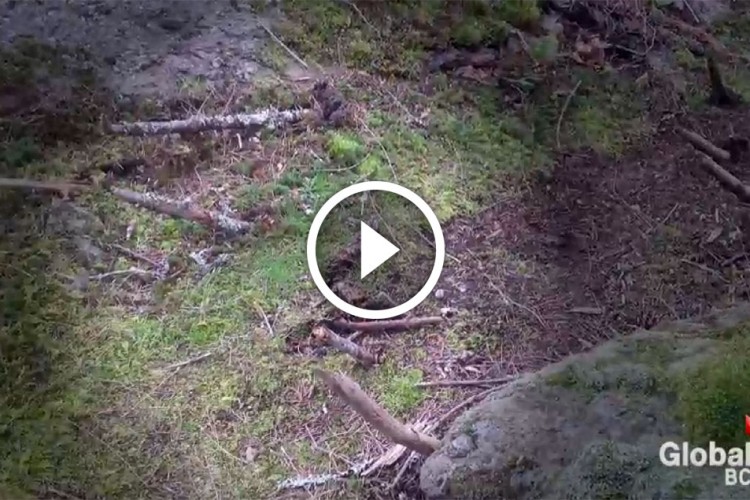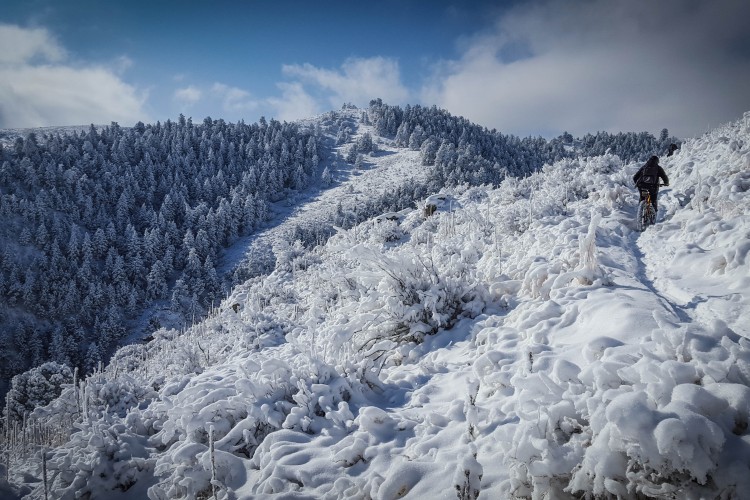
As the chairlift rose over talus piles, I looked down a few hundred feet and saw marmots scattered across the rocks, darting from one to another. Glacial runoff streams through carpets of peat moss and the temperature drops by 10 to 15 degrees. It’s a far departure from the sweat-streaming, fast laps in the hectic Whistler Bike Park below, and that’s a good thing.

Naturally, I was a little intimidated. The only form of life that appears to survive on the Whistler Peak are bits of moss, mountain bikers, camera-toting tourists, and fat rodents. By inference, it’s easy to tell that Top of the World is not going to be a swoopy, smooth trail that guides you from side to side down the mountain.
The antsy nerve feeling didn’t ease up after hopping off the chair, either. The trail actually starts after a short section of fireroad that completely drops off to the other side. My assumption — based on the warning at the lift ticket office that the Top of the World (TOTW) trail is for advanced riders only, and based on the fact that it’s an Enduro World Series stage — was that it might end up being a little too advanced, and I’d be doing boulder moves for 2,000 feet of vert down, or playing hop-a-rock on foot with my bike in my hands.

At this point, I’d found that for myself, single black diamond trails in the Whistler Bike Park were A-OK, and the double blacks could be a little dicey. Everything in Whistler seems to be turned up by about one to one-point-five levels. Might as well take a peek behind the curtain, I thought.
Top of the World starts with some steep rock lines that cut the elevation down quickly. If you like technical and steep, then you will love it. Although TOTW is near the top of the black diamonds in terms of difficulty with only a few others ahead of it before the double blacks on the trail progression matrix, other black diamonds which sit below it, like Duffman felt more technical to me.

TOTW is much steeper near the top, but that’s over quickly and the sections are easily conquered one at a time, by pointing and shooting. For example, put your front tire past the crest of a rocky drop, sight your exit line, release the brake levers, and grease it. Most of the technical sections were made to be tricky, but not overwhelming, and the rock work is excellent.
The first time I rode Top of the World in August of 2018, wildfire smoke wrapped the surrounding terrain and visibility was limited to a few hundred yards. This year during Crankworx in August of 2019, rain fell heavily on Whistler days prior. Jeff and I dropped in with a mild temperature and clear skies.

It was the same rush again, as we lost elevation quickly, escaped the mondo rock piles, and found treeline. There are a few flat sections of road that connect the trail during certain points. We upped our dropper posts and pedaled along a stretch when a light brown marmot, big as a trash-fed raccoon, ran in our opposite direction a few feet off the trail. I was hoping to see a bear, but this would have to do.

As the trail dropped back into the tree line, the soil grew more damp and ribbon-like. Rock piles make way for root gardens, compressions, and berms. It’s always a good idea to look ahead, but I kept my eyes on the sides of trails for kickers and bonus points, and there are a number of them as you drop lower on TOTW.

The scenery bursts with more deep greens, bottomless berms, and fun turns before spitting riders past a waterfall and onto another section of fireroad. More people seem to accumulate now that you’re nearing the top of Creekside.
After losing over two-and-a-half thousand feet over four miles, once you reach this point, you’ve got lightning in your veins and are itching for more. We hit the bottom of Freight Train and No Joke for a few rock rolls, right back into the bike park.

At this point, we felt that we earned our turns, which took on a different meaning. After steep and rocky, we rode into the blue-rated Una Moss / Weasel Juice trail, followed by Blueberry Bathtub for a few, easy-going berms and jumps toward the Fitzsimmons zone. After our arms and adrenaline recovered, we got into some tricky stuff again, with Angry Pirate followed by a mellower Samurai Pizza Cat. Whistler Bike Park takes the cake in terms of trail name creativity.

By starting at Top of the World and descending into the bottom of Whistler Bike Park, it gives you a mind blowing 5,000 feet of descending in a single shot. It is exhilarating and rugged at the top, but puts riders back into manageable terrain before you know it. Sure, it might not be the same as losing count of how many times you’ve ridden A-line in one day, but personally I’m more of a quality, rather than quantity kinda guy. That being said, we hopped back in the Fitzimmons lift line shortly after for another fun run and a short A-line lap with the rest of the village.
Need to know details

For sustainability reasons, Whistler Bike Park limits the amount of Top of the World trail lift tickets they sell each day. When the trail first opened, it was limited to 100 per day, but now they have increased the number to 300 TOTW tickets per day. The tickets cost an additional $22 on top of the normal bike park day pass, or the Express ticket allows for one Creekside Gondola lift and one Peak Chair lift and costs $39.
The Creekside Gondola is busy with sightseers and mountain bikers, and it can take an hour just to load the gondola. It’s best to have your ticket in hand, get in line early, and be prepared to cram in the gondola. It’s a little bit of a hassle, but it’s worth it.

As far as the right a bike on TOTW, I wouldn’t go with less than a 140mm, all-mountain or enduro rig. I rode the Canyon Spectral, a 150/160mm bike, and I wouldn’t want much less than that.
The Spectral handled the job well, and I was happy to have a 160mm fork up front to take the edge off of the rock gardens near the top of the trail. For a short review, see Jeff’s article here, when he tested the bike at Interbike last year.
Lastly, the Top of the World is one of the last mountain bike trails to open in the bike park, and might not be ridable until well into July, depending on the snowpack, so plan accordingly.



















